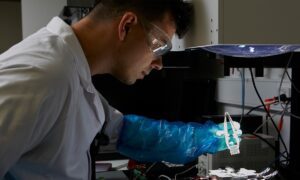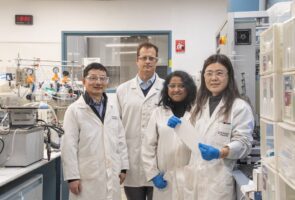An “unusual discovery” by Australian researchers claims to have resolved one of the fundamental challenges slowing the progress of perovskite solar cells, and it’s a solution that requires a little bit of “tough love.”
As the team from the ARC Centre of Excellence in Exciton Science explain it, metal-halide perovskites have promised to provide a cheap and flexible pathway for efficient solar PV, but still face a number of hurdles to widespread use in commercial applications.
As RenewEconomy has reported, this quest has claimed some scalps – including one of Australia’s longest running solar technology developers, GreatCell Solar (formerly known as DyeSol), which called in voluntary administrators in 2018 after failing to find funds to support a $25 million project to prove its technology.
One of the key problems preventing progress with perovskite solar cells has been their instability, which often comes down to light-induced phase segregation, in which sunlight, the very source of solar energy, disrupts the carefully arranged composition of elements within mixed-halide perovskites.
But in a report published in the journal Nature Materials on Monday, scientists across the Universities of Melbourne and Sydney, as well as from Monash University in Victoria, have discovered that high-intensity, glaring light can undo the very disruption caused by light at lower intensities.
According to the report, Dr Chris Hall, a member of Professor Trevor Smith’s team at The University of Melbourne, and Dr Wenxin Mao of Professor Udo Bach’s group at Monash University, first noticed the potential to explore this avenue of investigation during a separate experiment.
“It was one of those unusual discoveries that you sometimes hear about in science,” Hall said. “We were performing a measurement, looking for something else, and then we came across this process that at the time seemed quite strange. However, we quickly realised it was an important observation.”
At this point the team called on Dr Stefano Bernardi, from The University of Sydney, who led the computational modelling work to better understand what, exactly, was going on.
“What we found is that as you increase the excitation intensity, the local strains in the ionic lattice, which were the original cause of segregation, start to merge together. When this happens, the local deformations that drove segregation disappear.
“On a normal sunny day, the intensity is so low that these deformations are still localised. But if you find a way to increase the excitation above a certain threshold, for example by using a solar concentrator, then segregation disappears.”
The team says the implications of the findings are significant, with researchers now able to retain the optimal composition of elements within mixed-halide perovskites when they are exposed to light – which, of course, is necessary for its use in solar cells.
“A lot of people have approached this problem by investigating ways of suppressing light-induced disorder, such as looking at different compositions of the material or changing the dimensions of the material,” Dr Hall said.
“What we’ve shown is that you can actually use the material in the state that you want to use it, for a solar cell – all you need to do is focus more light onto it.
“An exciting extension of this work is that the ability to rapidly switch the bandgap with light opens an interesting opportunity to use perovskites in data storage,” Dr Mao said.
Dr Hall says that with this “fundamental work” done, the next step is to put the findings into practice in a device.










